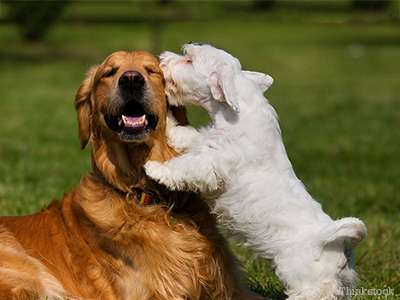I am never sure who the average family is, but at least statistically they do exist. Some have children and some have pets. Depending on which survey you read the number of children per family, the numbers of married couples and the number of pets seem to seesaw up and down from year to year. It makes for fascinating statistics and certainly tells us a lot about changes to come, but as I said, I don’t really think I know the “average” family and they seem to be a moving target. What I do know is that if you already have a dog and would like to bring home another, you should do so with the proper knowledge and understanding.
 How should I introduce two dogs?
How should I introduce two dogs?
It’s important to introduce a new dog in a similar way to introducing a new person. Remember, there is never a second chance to make a first impression. How, when and where dogs meet can impact their relationship and reduce some of the stress that might accompany that meeting.
The ASPCA recommends that you, “Introduce your dogs on neutral territory, like on a short walk through your neighborhood, in a nearby park or in a friend’s yard.” Don’t go alone, have one person to handle each dog, while keeping both dogs on leashes. Walk the dogs either side-by-side or one in front of the other, walk at a relaxed pace and keep the leashes loose.
Don’t force interaction between the dogs. It’s okay if they don’t immediately bond. Let them get to know one another at their own pace.
Even if your dogs do get along great, they’ll probably need time alone once you get home. Crate train each dog or find them each a safe, private place so they both have a dedicated spot where they know they can be alone. If the dogs do get along, you can let them at least be able to see each other when you leave the house, this can often offer comfort.
Why might my first dog be uncomfortable about a new dog?
Think about it from your first dog’s perspective. The chances are pretty good that he has things the way he wants them:
- His eating and sleeping places
- His bed and bowls
- His smell
- His schedule for feeding, playing and sleeping
You may be able to think of a past situation when guests—even guests you like—overstay their welcome or assume their privileges. It can bring a lot of tension and even an end to a friendship. Now imagine having a stranger come over, plop themselves down and say, “I think I will stay forever.”
When is the right time to bring another dog into the house?
If you’ve had a change in your life—a recent move, a new roommate, a new job—that will mean a change in your dog’s routine, it may not be the best time to bring home a new dog. It’s unlikely that you’ll have time to help both dogs adapt. You may not be able to give either dog the extra time and attention that will be required for a healthy transition.
Helping new puppies to get along with adult dogs
As anyone who has ever had a puppy will tell you, they can often be a handful. Puppies can really annoy adult dogs. They simply don’t have the social skills or limitations that come with time. (Think about the 3-year-old boy that lives next door.)
Even adult dogs with good temperaments will growl or snarl at puppies to set boundaries. This is normal and can be a good thing. Never allow a puppy and an adult dog to be left alone together though, for the safety of both dogs. Also, give your adult dog plenty of time away from the puppy, and try to give him some quality time alone with you and your family whenever circumstances permit it.
If you have any questions or concerns, you should always visit or call your veterinarian -- they are your best resource to ensure the health and well-being of your pets.
